With an institutional life story more than 175 years in the making, Baldwin Wallace University has been shaped by a significant portion of U.S. history, including all the major armed conflicts starting with the Civil War.
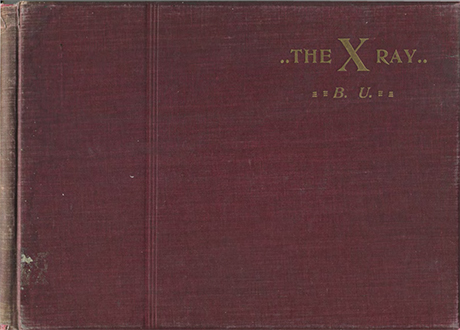 Writing
in
the
1898
yearbook
"The
X
Ray"
for
then-Baldwin
University,
Arthur
H.
Perry
recalled
the
devastation
of
the
"Great
Rebellion."
Writing
in
the
1898
yearbook
"The
X
Ray"
for
then-Baldwin
University,
Arthur
H.
Perry
recalled
the
devastation
of
the
"Great
Rebellion."
"When the college was in its most flourishing condition and its classes filled to overflowing … the dark cloud of war suddenly overspread our fair land. There was a call to arms. Sumpter had been fired upon. Books were thrown down, studies forgotten, and with few exceptions, all who were eligible marched to the front …
Few ever came back to finish their college course. Many gave up their lives to uphold their country's honor, and instead of their names being enrolled among those of the alumni, they may be found engraved on the marble tablets in the beautiful Soldiers' and Sailors' Monument in Cleveland."
Among the lost were two of the five promising graduates to earn the very first bachelor's degrees awarded by Baldwin University, who "met their end during the Civil War."
As so many male students went off to the battlefields, women outnumbered men in the remaining ranks of students during the era.
The same gender imbalance occurred when World War I erupted just a few years after the 1913 merger of Baldwin University and nearby German Wallace College. The 1920 "Grindstone" yearbook bemoaned that "the fate of athletics at Baldwin-Wallace hangs in the balance" due to the loss of athletes to military service. In fact, BW decided to withdraw from conference competition because "to remain there always at the bottom of the list was undesirable."
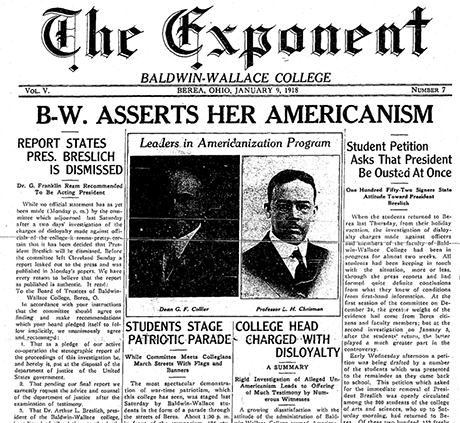 With
the
declaration
of
war
on
Germany
in
1917,
anti-German
nationalism
also
emerged
along
with
a
new
BW
Men's
Patriotic
League.
The
league
successfully
pushed
to
update
the
inscription
cut
into
the
stone
of
the
Conservatory
building
from
"German
Wallace
College"
to
"Baldwin-Wallace
College."
With
the
declaration
of
war
on
Germany
in
1917,
anti-German
nationalism
also
emerged
along
with
a
new
BW
Men's
Patriotic
League.
The
league
successfully
pushed
to
update
the
inscription
cut
into
the
stone
of
the
Conservatory
building
from
"German
Wallace
College"
to
"Baldwin-Wallace
College."
Although BW President Arthur Breslich, a German immigrant, declared his allegiance to the U.S., he was ousted by the BW Trustees, who noted that he never "unequivocally denounced the crimes and atrocities of Germany." A 1918 issue of The Exponent described his patriotism as "passive and colorless rather than active and inspiring."
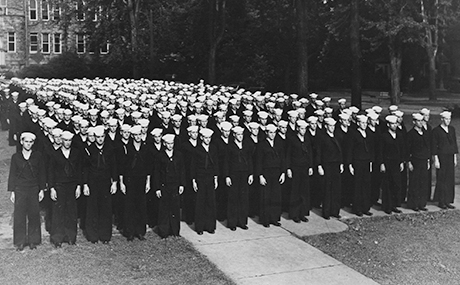 The
adaptation
to
World
War
II
brought
different
changes.
Shortly
before
the
attacks
on
Pearl
Harbor,
with
military
service
once
again
looming
for
many
students,
BW
rolled
out
an
accelerated,
year-round
schedule
with
12-week
terms
that
enabled
students
to
graduate
in
less
than
three
years.
The
adaptation
to
World
War
II
brought
different
changes.
Shortly
before
the
attacks
on
Pearl
Harbor,
with
military
service
once
again
looming
for
many
students,
BW
rolled
out
an
accelerated,
year-round
schedule
with
12-week
terms
that
enabled
students
to
graduate
in
less
than
three
years.
In mid-1942, the ranks of male students actually swelled as the Navy established a V-12 unit for the technical training of Naval officers at BW. The program brought more than 350 men to campus.
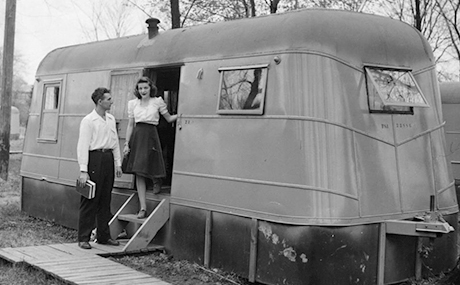 Among
the
changes
made
to
meet
the
influx
of
these
student
sailors
was
the
addition
of
a
swimming
pool
for
aquatic
training
and
a
trailer
park
on
north
campus
where
many
V-12
Program
participants
and
their
spouses
lived.
Among
the
changes
made
to
meet
the
influx
of
these
student
sailors
was
the
addition
of
a
swimming
pool
for
aquatic
training
and
a
trailer
park
on
north
campus
where
many
V-12
Program
participants
and
their
spouses
lived.
Former BW Historian Jeremy Feador told cleveland.com, "There was no running water, and they did their laundry under the stadium." As the last of the trailer homes were sold off in 1953 (at the close of the Korean conflict), The Exponent noted that there had been 55 trailers in use at the park's peak.
In 1946, as returning veterans began to enroll in droves on the GI Bill, BW innovated once again by offering evening classes to meet the demand of working adult students. By 1965, it was possible to earn a BW degree entirely in evening classes.
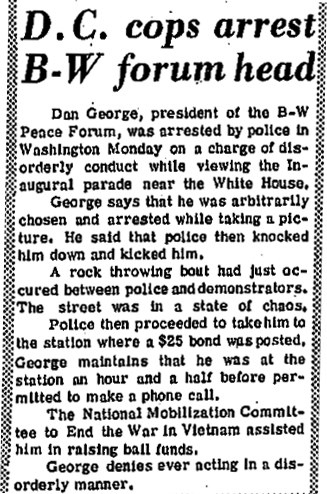 During
the
Vietnam
War
era,
an
estimated
one-quarter
of
the
student
body
joined
a
nationwide
college
strike
to
protest
U.S.
military
involvement
in
Cambodia.
Students
also
passed
petitions,
student
senate
resolutions
and
carpooled
to
Washington,
D.C.,
protests
where
the
president
of
the
BW
Peace
Forum
was
arrested.
During
the
Vietnam
War
era,
an
estimated
one-quarter
of
the
student
body
joined
a
nationwide
college
strike
to
protest
U.S.
military
involvement
in
Cambodia.
Students
also
passed
petitions,
student
senate
resolutions
and
carpooled
to
Washington,
D.C.,
protests
where
the
president
of
the
BW
Peace
Forum
was
arrested.
A day after the National Guard shooting that left four Kent State students dead, 500 BW students gathered on the Berea triangle for a candlelight march. The May 8, 1970 issue of The Exponent described all the anti-war activity as "active and non-violent means of expressing concern."
In recent years, veterans who've done tours in Middle East conflicts or served in locations around the world find specialized services to meet their needs at BW. With a focus on supporting the transition to civilian life and careers, the University is recognized as a Yellow Ribbon school by the Department of Veterans Affairs and named a Military-Friendly School by G.I. Jobs magazine.
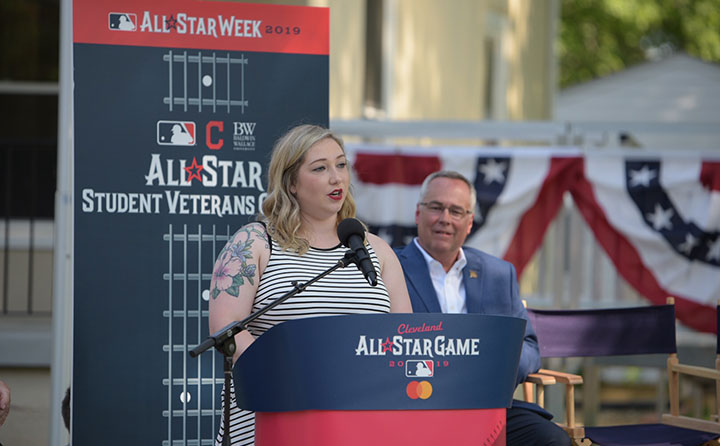
In July of 2019, Major League Baseball (MLB) and the Cleveland Indians unveiled a new All-Star Student Veterans Center at BW, a "Legacy Project" tied to the Indians hosting MLB's annual Midsummer Classic.
Calling BW student veterans "a family," Britnee Davis, then-president of BW's Student Veteran Organization (SVO), expressed extreme gratitude for the gift of the new center to elevate support for "our brothers and sisters in transition."
"I can't imagine where I would be today had I not received the support and commitment from our veterans support program here at Baldwin Wallace," she said.
Find out more information on current military and veterans services at BW.